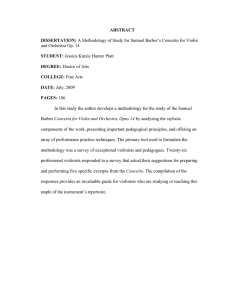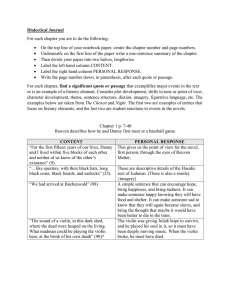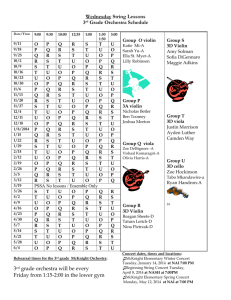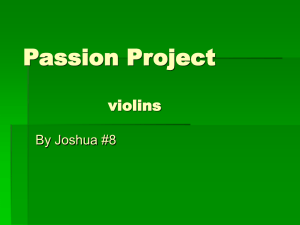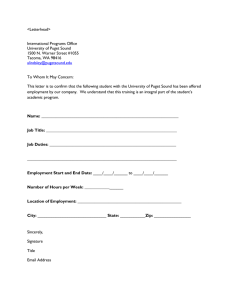ZACHARY HAMILTON ’15, VIOLIN SCHOOL OF MUSIC JUNIOR RECITAL SUNDAY, NOV. 17, 2013
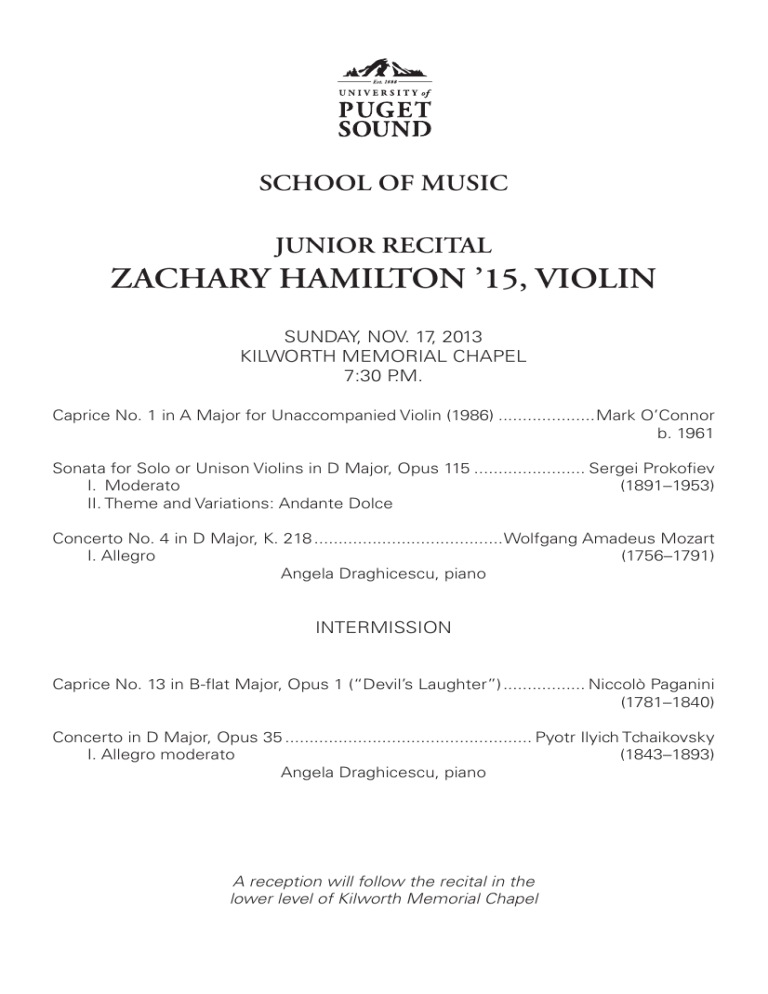
SCHOOL OF MUSIC
JUNIOR RECITAL
ZACHARY HAMILTON ’15, VIOLIN
SUNDAY, NOV. 17, 2013
KILWORTH MEMORIAL CHAPEL
7:30 P.M.
Caprice No. 1 in A Major for Unaccompanied Violin (1986) ....................Mark O’Connor b. 1961
Sonata for Solo or Unison Violins in D Major, Opus 115 ....................... Sergei Prokofiev
Moderato (1891–1953)
II. Theme and Variations: Andante Dolce
Concerto No. 4 in D Major, K. 218 .......................................Wolfgang Amadeus Mozart
Allegro (1756–1791)
Angela Draghicescu, piano
INTERMISSION
Caprice No. 13 in B-flat Major, Opus 1 (“Devil’s Laughter”) ................. Niccolò Paganini
(1781–1840)
Concerto in D Major, Opus 35 ................................................... Pyotr Ilyich Tchaikovsky moderato
Angela Draghicescu, piano
(1843–1893)
A reception will follow the recital in the lower level of Kilworth Memorial Chapel
VIOLINIST
After beginning violin at age 6, ZACHARY HAMILTON began pursuing classical violin seriously at 17. Now a violin performance major at Puget Sound, he studies concurrently with Timothy Christie and Maria Sampen. He has played in masterclasses for Paul Kantor, Gerardo Ribeiro, Mark Fewer, and Mimi Zweig, among others, in addition to working privately with Lina Bahn, David Gillham, and Nancy
Dahn. Past full-time teachers include Mika Krstic and Steven Zander. Since high school Zachary has spent his summers at Brevard Music Center, Mammoth Lakes
Music Festival, Northwestern Violin Institute, and Le Domaine Forget Academie in
Québec. In the spring he will be studying music and German in Vienna.
ACCOMPANIST
ANGELA DRAGHICESCU earned her master’s and bachelor’s of musical arts degrees in piano performance at Louisiana State University, where she worked with
Michael Girt and Willis Delony. Recently Dr. Draghicescu served as teaching assistant in the Collaborative Piano Program at The University of Texas at Austin, where she also completed her D.M.A. under the mentoring of Anne Epperson. Dr. Draghicescu currently serves as staff collaborative pianist at Seattle Pacific University.
ACKNOWLEDGMENTS
I first would like to thank my mom and dad. I recognize that financial and emotional support for the pursuit of music is not something to be taken for granted. Overcome with gratitude, I frequently find myself humbled and driven by your encouragement.
My teachers Maria Sampen and Tim Christie also deserve my utmost gratitude. In addition to your musical guidance over the last two years, you have provided me with a unique educational experience and have each equipped me in your own way through lessons, preparing me for summer festivals, auditions, and this recital.
Lastly, my thanks extends to my friends, who have been relentlessly supportive this semester, and to the School of Music faculty as a whole, who have been a network of wisdom and encouragement.
PROGRAM NOTES
Mark O’Connor’s Caprice No. 1 (1986) is the first of his Six Caprices for Solo Violin, which was intended to be the first of 24 for the solo violin. Envisioning himself as the
“modern-day Paganini,” O’Connor intended to emulate Niccolò Paganini’s virtuosic 24
Caprice , Opus 1, an example of which will be played later in the program.
In modeling his six caprices from Paganini’s first opus, O’Connor mixes technical brilliance with sharp character contrasts, but trades the Romantic European tradition for that of American fiddling. The composer consulted classical virtuoso violinist
Rachel Barton-Pine for technical and editorial input, ultimately producing a flashy yet musically satisfying six-part complement to Paganini’s 24.
Sonata for Solo or Unison Violin, Opus 115 , was Prokofiev’s last piece written for the violin. The work was never performed during the composer’s lifetime, and remains his least-performed work for violin, behind the concertos and piano-violin sonatas. Seldom performed in unison, the sonata has been published several times as a sonata exclusively for solo violin, and perhaps rightly so. Try to imagine 25 student violinists, the ensemble he originally intended, attempting to perform the rubatos and character changes demanded in this work.
Like Tchaikovsky, Prokofiev was a prolific ballet composer. It is possible to listen to much of his compositional output as balletic in some form or another, and the first movement is one such instance. In the first four bars, Prokofiev creates four characters, each created by different bowstrokes and harmonies. Each character develops, just as one might in a ballet, throughout the movement.
The second movement is a prime example of Prokofiev’s magical creation of melody.
While the first phrase appears almost simplistic, the reach to the high octave do on eighth notes in the second phrase, colors the entire melody. With these two notes,
Prokofiev transforms a simple tune into a memorable lullaby; the following five variations color this melody further without obstructing its simplicity.
Mozart’s Violin Concerto No. 4, K. 218 , was one of five concertos the composer wrote at age 19. Primarily an opera composer, Mozart ought to be considered operatic, as Prokofiev and Tchaikovsky are considered balletic. To this end the violin is used to sing, resembling the contours of the human voice. Mozart also uses traditional classical dances–gavotte and bourree, for example, resulting in characters surprising, joyful, and sly.
In Mozart’s time, it was common to write or improvise one’s own cadenza in concert.
In this tradition, and for the fun of it, I will be performing my own cadenza for the concerto, featuring themes throughout the movement and perhaps elsewhere as well. Please enjoy the premiere of this original cadenza!
Concerto in D Major, Opus 35 , is one of Tchaikovsky’s most famous works, and one of the most performed in the solo violin repertoire. Yet, the premiere of the concerto, given in 1881 by Adolph Brodsky, was a critical failure.
The fate of the concerto, however, has proven much more fortunate. Since the premiere the concerto has become a staple of the violin repertoire, with some soloists recording the piece several times. Massive in emotional scope and sheer breadth, the first movement alone is around 20 minutes. Tchaikovsky’s Violin
Concerto has become a touchstone of individuality–each violinist plays it to his or her own musical tastes. The piece has come to reflect both composer and performer equally, a rare achievement for any classical composer.
—notes compiled by Zachary Hamilton
UPCOMING ARTS AND LECTURES
Information: 253.879.3555 | pugetsound.edu/calendar
Puget Sound is committed to being accessible to all people. If you have questions about event accessibility, please contact 253.879.3236, accessibilty@pugetsound.edu, or pugetsound.edu/accessibility
NOVEMBER
Monday, Nov. 18–Saturday, Dec. 14 Kittredge Gallery: Art Students Annual , opening reception on
Wednesday, Nov. 20, 5–7 p.m.
Tuesday, Nov. 19, 5:30–7 p.m. Guest Lecture: “Dead Portraits in a Living Room: Exploring
Cultural Unity in the Caribbean and Central America,” by Gregory Wilson part of The Caribbean
Writers Series , Rasmussen Rotunda, Wheelock Student Center. Free
Wednesday, Nov. 20, 7:30 p.m. Guest Recital: Gregory Lee, professor of violin, University of
Oklahoma, concertmaster of Oklahoma City Philharmonic, Schneebeck Concert Hall. Free
Friday, Nov. 22, 7:30 p.m. Faculty Recital: Dawn Padula, mezzo-soprano, and Tanya Stambuk, piano, Schneebeck Concert Hall. Tickets: $12.50 general; $8.50 seniors, students, military, Puget
Sound faculty/staff; free for Puget Sound students, available at Wheelock Information Center,
253.879.6013, and online at tickets.pugetsound.edu, and at the door.
Monday, Nov. 25, 6 & 7:30 p.m. Student Chamber Music Concerts, David Requiro, director,
Schneebeck Concert Hall. Free
Monday, Dec. 2, 7:30 p.m. Swope Lecture: “The New Religious Intolerance” by Martha
Nussbaum, Schneebeck Concert Hall. Free but ticketed. Tickets: available at Wheelock
Information Center, 253.879.6013, and online at tickets.pugetsound.edu.
Friday, Dec. 6, 7:30 p.m. Concert Band and Wind Ensemble, The Three Embraces, Gerard Morris, conductor, Schneebeck Concert Hall. Free
Saturday, Dec. 7, 7:30 p.m. and Sunday, Dec. 8, 2 p.m. Adelphian Concert Choir and Voci d’Amici,
A Winter’s Hope , Steven Zopfi, conductor, holiday concert, Kilworth Memorial Chapel. Tickets:
$8.50 general; $4.50 seniors, students, military, Puget Sound faculty/staff/students, available at
Wheelock Information Center, 253.879.6013, online at tickets.pugetsound.edu, and at the door.
Sunday, Dec. 8, 7 p.m. Festival of Lessons and Carols, Kilworth Memorial Chapel. Free but please bring canned food donation.
The School of Music at University of Puget Sound is dedicated to training musicians for successful music careers and to the study of music as a liberal art. Known for its diverse and rigorous educational program, personalized attention to students, the stature of its faculty, and superior achievements in scholarship, musicianship, and solo and ensemble performance, the school maintains the highest professional standards while providing academic and performance opportunities to all university students. Through faculty, student, and guest artist colloquia, workshops, performances, and a vibrant Community Music department, the School of Music enriches the cultural life of the campus and community.
pugetsound.edu/music | 253.879.3700
